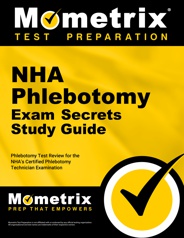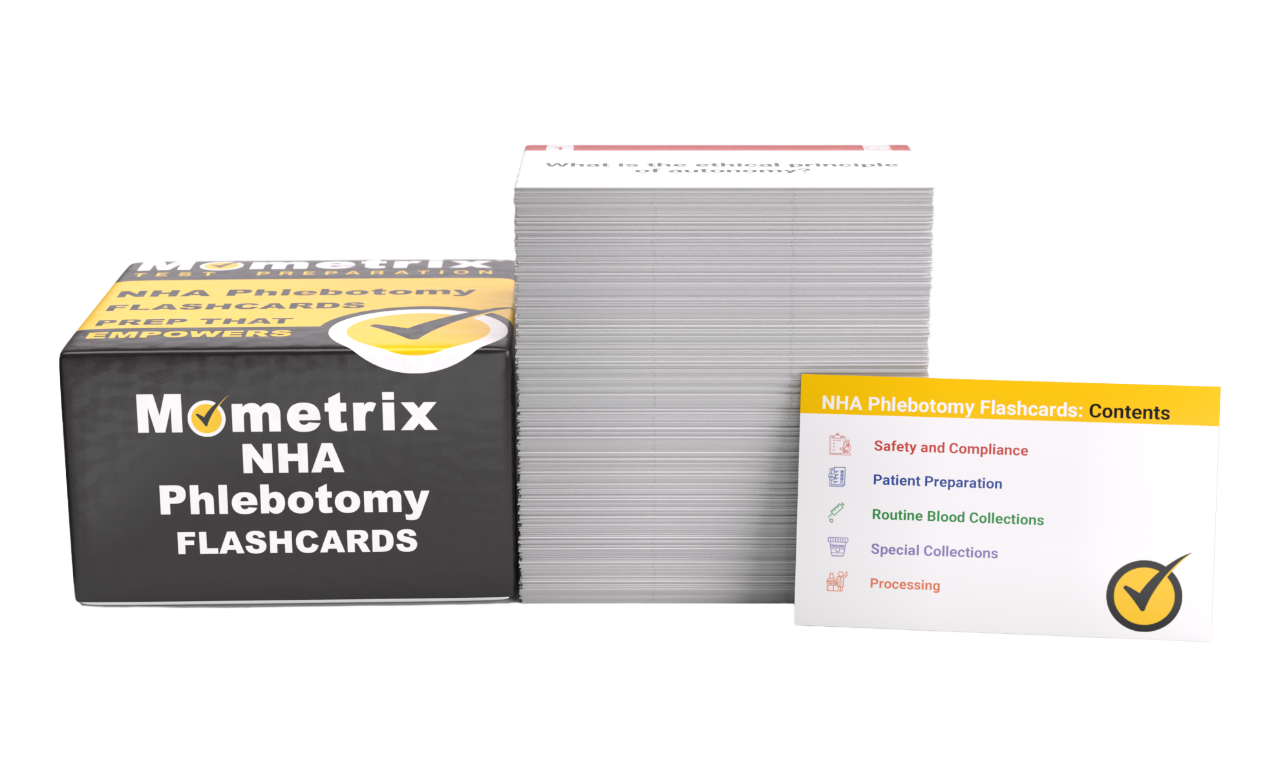
If you are considering a fascinating career as a certified phlebotomy technician, this review is designed to help you learn what you need to know to be prepared for the certification examination.
Click “Start Test” above to take a free CPT practice test, and check out our premium-quality CPT test prep resources by clicking the links below!
The CPT exam is the certification exam developed by the National Healthcare Association to determine the skill levels and knowledge of applicants desiring to become certified phlebotomy technicians.
Phlebotomy technicians are essential parts of the healthcare system, needed in clinics, doctor offices, hospitals, and laboratories all across the country. These professionals draw blood and prepare the blood so the tests that doctors have ordered can be run.
According to research done by the Bureau of Labor and Statistics, the demand for certified phlebotomy technicians will increase by as much as 22% over the next 8-10 years.
Check Out Mometrix's NHA Phlebotomy Study Guide
Get practice questions, video tutorials, and detailed study lessons

Think you aren’t a good test-taker? Maybe on a study-time crunch? Or just don’t know how to begin studying? Mometrix has designed a new Study Secrets course to help every student, no matter what study scenario you are in. Here’s what you’ll find in the Study Secrets Course:
Everyone learns differently, so we’ve tailored our Study Secrets Course to ensure every learner has what they need to prepare for their upcoming exam or semester. Click below to check it out!
In order to register for the CPT examination, you have to meet the eligibility requirements.
Each applicant is required to have a high school diploma or a GED certificate.
Each applicant must complete a training program from an accredited or state-approved learning institution.
Applicants who received formal medical services training in the health field while training or serving in any branch of the military meet the educational training requirements as long as their training was completed within the last five years. Training received through the military will require relevant work experience in conjunction with the training.
Work experience will include a minimum of one year of experience working in a health services field approved by the NHA. This period of hands-on work experience has to have been completed within the last three years.
During your certified training course, or through your work experience, you will have to have completed a minimum of 30 successful venipunctures and 10 successful capillary sticks.
The blood draws will have to have been performed on live persons, and you will need to provide evidence of the punctures and sticks.
The CPT test is divided into five sections. You will need to have core knowledge that may be used in any portion or section of the test to assess your basic knowledge, including:
Questions in each section will assess the knowledge, information, and concepts a phlebotomist must know, as well as tasks or duties that a phlebotomist must be able to perform.
The Safety and Compliance section of the CPT exam focuses on the various hazards of working with blood specimens and how to be in compliance with safety regulations. Here’s a look at the details you’ll be asked about in this section:
The Patient Preparation section of the CPT exam focuses on introducing yourself to the patient, explaining procedures, determining the best collection site, and verifying patient compliance. Here’s a closer look at the details of this section:
The Routine Blood Collections section of the CPT exam focuses on day-to-day tasks, labeling specimens, post-procedure patient care, tourniquet application, and order of draw on a venipuncture. Here’s a look at the details of this section:
The Special Collections section of the CPT exam focuses on atypical blood collections, peripheral blood smears, blood culture collections, and collections for blood donations. Here’s a closer look at what this section of the test pertains to:
The Processing section of the CPT exam focuses on the guidelines and procedures used after the specimen is obtained. Specifically, these are the main points that this section will cover:
Think you aren’t a good test-taker? Maybe on a study-time crunch? Or just don’t know how to begin studying? Mometrix has designed a new Study Secrets course to help every student, no matter what study scenario you are in. Here’s what you’ll find in the Study Secrets Course:
Everyone learns differently, so we’ve tailored our Study Secrets Course to ensure every learner has what they need to prepare for their upcoming exam or semester. Click below to check it out!
If you do not have a passing grade after the first attempt, you will need to wait thirty days before you will be eligible to retake the test.
If you do not have a passing grade after the second attempt, you will need to wait an additional thirty days before you will be eligible to retake the exam a second time.
If you do not have a passing grade after the third attempt, you will need to wait twelve months before you will be eligible to retake the exam a fourth time.
After the fourth attempt at taking the exam, you will have a mandatory waiting time of twelve months before you can apply to take the test again.
Check Out Mometrix's NHA Phlebotomy Flashcards
Get complex subjects broken down into easily understandable concepts

To register for the exam, visit the National Health Association’s website. At the top of the landing page, on the right-hand side, you will see an orange button that allows you to either log in to an existing account or create a new account.
When you create the account, you will provide your first and last name, email address, and mobile phone number. Additional information like your mailing address will also be required. When you are ready to register for the test, you simply log into your NHA account and follow the onscreen prompts.
Remember your login information; when you are ready to see your test scores, you will need to log into your account again.
You will need a current government-issued identification card or driver’s license with your photo. The name on your identification must be an exact match to the name you are registered under for the test.
You will need a current government-issued identification card or driver’s license with your photo. You will also need to bring two number-2 pencils that are sharpened and ready to use.
When you register for the exam, you will be allowed to choose at which approved location you will be taking the test. All locations will require a government-issued photo ID for verification before you begin the test.